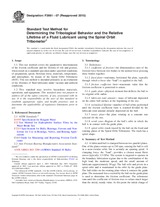We need your consent to use the individual data so that you can see information about your interests, among other things. Click "OK" to give your consent.
ASTM F2661-07(2015)
Standard Test Method for Determining the Tribological Behavior and the Relative Lifetime of a Fluid Lubricant using the Spiral Orbit Tribometer
STANDARD published on 1.4.2015
The information about the standard:
Designation standards: ASTM F2661-07(2015)
Note: WITHDRAWN
Publication date standards: 1.4.2015
SKU: NS-611294
The number of pages: 7
Approximate weight : 21 g (0.05 lbs)
Country: American technical standard
Category: Technical standards ASTM
The category - similar standards:
Annotation of standard text ASTM F2661-07(2015) :
Keywords:
accelerated testing, boundary lubrication, fluid lubricants, friction coefficient, greases, tribology, relative lifetimes, vacuum tribology,, ICS Number Code 75.100 (Lubricants, industrial oils and related products)
Additional information
| Significance and Use | ||||||||||
|
5.1 Relevance of the Spiral Orbit Tribometer (SOT)—The SOT was designed to evaluate the relative degradation rates of liquid lubricants in a contact environment similar to that in an angular contact bearing operating in the boundary lubrication regime. It functions as a screening device to quickly select the lubricants, evaluate the ability of various components of a lubricant (base oil, thickener, or additive) to lubricate a contact in rolling, pivoting, and sliding conditions simultaneously, and study their chemical decomposition if necessary. The SOT provides a means to study the tribological behavior of oils and greases during operation, while they undergo changes as a function of typical parameters encountered in the lubrication field (temperature, environment, materials used, load applied, and speed). Test conclusion is defined to be when a friction coefficient limit (typically an increase of 0.1 above the steady state value) is surpassed. Normalized lubricant lifetime is then defined as the number of orbits completed divided by the initial amount of lubricant used (in μg). The SOT was initially developed to evaluate lubricants for space applications, but is also relevant for conventional environments. Some results in vacuum are presented (Fig. 1). At this time, no data for tests in ambient conditions have been published (see Fig. 2). The user of this test method should determine to their own satisfaction whether results of this test procedure correlate with field performance or other bench test procedures. 1.2 This standard may involve hazardous materials, operations, and equipment. This standard does not purport to address all of the safety concerns, if any, associated with its use. It is the responsibility of the user of this standard to establish appropriate safety and health practices and to determine the applicability of regulatory limitations prior to use. |
||||||||||
| 2. Referenced Documents | ||||||||||
|
We recommend:
Technical standards updating
Do you want to make sure you use only the valid technical standards?
We can offer you a solution which will provide you a monthly overview concerning the updating of standards which you use.
Would you like to know more? Look at this page.




 Cookies
Cookies
